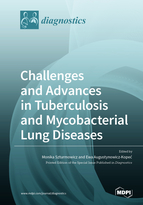Challenges and Advances in Tuberculosis and Mycobacterial Lung Diseases
A special issue of Diagnostics (ISSN 2075-4418). This special issue belongs to the section "Diagnostic Microbiology and Infectious Disease".
Deadline for manuscript submissions: closed (30 June 2022) | Viewed by 29326
Special Issue Editors
Interests: cardiac sarcoidosis; venous thromboembolism management and treatment; interstitial lung diseases, diagnosis and treatment; COVID-19 lung disease; pericardial diseases
Special Issues, Collections and Topics in MDPI journals
Interests: clinical microbiology; microbiological diagnostics of tuberculosis and mycobacteriosis
Special Issues, Collections and Topics in MDPI journals
Special Issue Information
Dear Colleagues,
Tuberculosis (Tb) is the leading cause of morbidity worldwide. According to the WHO, the estimated number of active Tb cases in 2019 was 10 million, while 1,2 million died of this disease. A significant epidemiological and clinical problem concerns the coinfection of M. tuberculosis and HIV, as well as the growing number of patients diagnosed with multi-resistant (MDR) or extensively resistant (XDR) Tb.
Non-tuberculous mycobacteria (NTM) are the environmental opportunistic pathogens present in soil, water, and water-aerosols. Non-tuberculous mycobacterial lung diseases (NTMLD) are increasingly recognised all over the world, especially in the ageing populations and in patients diagnosed with chronic lung diseases. The largest clinical problem concerns differentiating respiratory colonization from NTMLD. The spectrum of responsible NTM species is evolving, requiring the application of newer methods of identification.
The presently announced Special Issue entitled “Challenges and Advances in Tuberculosis and Mycobacterial Lung Diseases” will encompass research articles, case presentations, and literature reviews concerning the epidemiology, medical surveillance, as well as diagnostic and therapeutic challenges in tuberculosis and in NTM infections.
This Special Issue will explore, but is not restricted to, the following topics:
- Molecular and genotyping of M. tuberculosis for rapid identification of MDR and XDR clones, and surveillance of their transmission routes;
- Latent tuberculosis testing and surveillance of active Tb in risk groups;
- Advances in the identification of non-tuberculous mycobacteria and differentiation to the species level;
- Drug susceptibility profile and antimicrobial resistance mechanisms; and
- Clinical problems concerning the recognition of NTMLD in patients with chronic lung diseases.
We hope that the published data will contribute to scientific discussion concerning these global health problems.
Prof. Dr. Monika Szturmowicz
Prof. Dr. Ewa Augustynowicz-Kopeć
Guest Editors
Manuscript Submission Information
Manuscripts should be submitted online at www.mdpi.com by registering and logging in to this website. Once you are registered, click here to go to the submission form. Manuscripts can be submitted until the deadline. All submissions that pass pre-check are peer-reviewed. Accepted papers will be published continuously in the journal (as soon as accepted) and will be listed together on the special issue website. Research articles, review articles as well as short communications are invited. For planned papers, a title and short abstract (about 100 words) can be sent to the Editorial Office for announcement on this website.
Submitted manuscripts should not have been published previously, nor be under consideration for publication elsewhere (except conference proceedings papers). All manuscripts are thoroughly refereed through a single-blind peer-review process. A guide for authors and other relevant information for submission of manuscripts is available on the Instructions for Authors page. Diagnostics is an international peer-reviewed open access semimonthly journal published by MDPI.
Please visit the Instructions for Authors page before submitting a manuscript. The Article Processing Charge (APC) for publication in this open access journal is 2600 CHF (Swiss Francs). Submitted papers should be well formatted and use good English. Authors may use MDPI's English editing service prior to publication or during author revisions.
Keywords
- tuberculosis
- MDR Tb
- XDR Tb
- epidemiology and surveillance
- genotyping
- nontuberculous mycobacteria
- treatment outcomes
- risk groups
- high resolution computed tomography
- HIV-AIDS
- COVID 19
Related Special Issue
- Recent Advances in Nontuberculous Mycobacteria (NTM) in Pathogens (7 articles)








